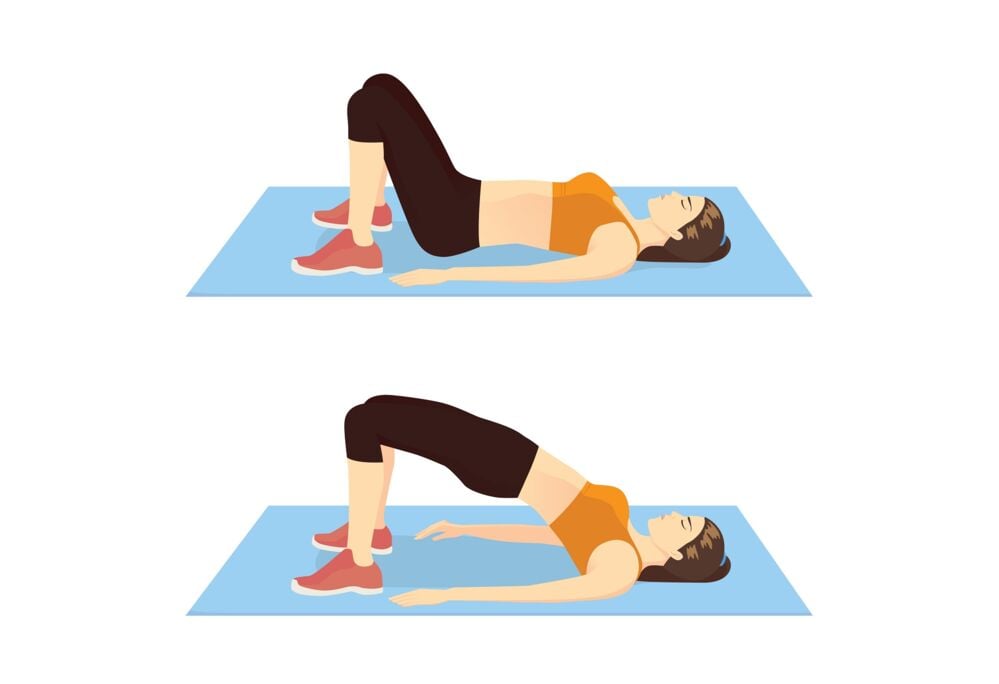If you want to get back to exercise after delivery, there are a few factors to consider. Since no two births are alike, your case needs to be assessed according to your unique needs. Here, we'll look at what exercises can help speed up recovery and which are better to put off for a while.
-
Tracking cycle
-
Getting pregnant
-
Pregnancy
-
Help Center
-
Flo for Partners
-
Anonymous Mode
-
Flo app reviews
-
Flo Premium New
-
Secret Chats New
-
Symptom Checker New
-
Your cycle
-
Health 360°
-
Getting pregnant
-
Pregnancy
-
Being a mom
-
LGBTQ+
-
Quizzes
-
Ovulation calculator
-
hCG calculator
-
Pregnancy test calculator
-
Menstrual cycle calculator
-
Period calculator
-
Implantation calculator
-
Pregnancy weeks to months calculator
-
Pregnancy due date calculator
-
IVF and FET due date calculator
-
Due date calculator by ultrasound
-
Medical Affairs
-
Science & Research
-
Pass It On Project New
-
Privacy Portal
-
Press Center
-
Flo Accuracy
-
Careers
-
Contact Us
Exercise After Cesarean Delivery: What Is and Isn’t Safe


Every piece of content at Flo Health adheres to the highest editorial standards for language, style, and medical accuracy. To learn what we do to deliver the best health and lifestyle insights to you, check out our content review principles.
Cesarean section delivery
Since the 1990s, rates of cesarean section deliveries have been steadily increasing around the world. In 2018, 21% of all births were delivered by C-section, according to data collected from 169 countries. In North America, more than 30% of all births are C-section deliveries.
As common as cesarean sections have become, the procedure is still major surgery and should be regarded as such. Like all other major surgeries, it takes weeks for proper recovery and healing after a C-section.
Exercise after C-section delivery usually needs to be postponed for longer than after a vaginal delivery. It’s also important not to push yourself too hard after a C-section: doing so can elevate the risk of infection and other complications that can prolong your recovery.
Take a quiz
Find out what you can do with our Health Assistant
When is it safe to exercise after cesarean delivery?
If you’ve had a C-section delivery, wait to jump into your post-pregnancy exercise regimen until at least six weeks postpartum, after you’ve visited your health care provider. Passing these two milestones before you begin exercising is vital to ensuring that your recovery goes smoothly.
Even people who had smooth deliveries need to be careful about postnatal exercise. Childbirth and cesarean section deliveries are traumatic to the body, and overexertion can cause problems.
If you want to get your body moving before your 4–6 week postnatal check-up, start with gentle, low-impact activity, like walking.
Once your health care provider has given you the thumbs up for exercise after delivery, you can slowly ease yourself back into a regular workout routine over a few weeks or months. Postnatal exercise after a C-section may look very different from your pre-pregnancy exercise regimen, but that’s perfectly okay.
Gentle exercises for the first six weeks
High-impact exercise, tummy-toning workouts, and full-blown cardio are definite no-no’s for the first six weeks after a C-section delivery. Here are some things you can do as soon as you feel up to it:
- Walking — As soon as you can get up and move around, venture out of the house and around the block a few times. It’ll probably feel great to get your body moving again.
- Pelvic floor exercises — You may have already been doing pelvic floor exercises throughout your pregnancy, and if you have, you know how important they are. As soon as the catheter is out, you can resume doing Kegel exercises to strengthen the pelvic floor muscles that support your bladder, bowel, and uterus.
- Practice good posture — Pregnancy, C-section, and breastfeeding can all contribute to bad posture. Practice sitting up with your back straight and your shoulders back. This will help you to strengthen your stomach muscles and support your back.
- Light stretches — Focus on stretching your neck, shoulders, arms, and legs with light stretches that don’t put pressure on your C-section scar.
Abdominal exercises after C-Section delivery
Even after you’ve gotten the green light to exercise after C-section delivery, it’s important to ease into abdominal exercises.
Before you exercise to strengthen abdominal wall muscles, make sure you don’t have a condition called diastasis recti, which is when there’s a gap in the rectus abdominis muscles of more than 2.7 centimeters after pregnancy. A gap in the rectus abdominis muscles isn’t considered dangerous, but it can create the appearance of pregnancy long after you have delivered. If you have diastasis recti, your health care provider may recommend modified workouts.
If you’re specifically looking for exercises to reduce your belly after delivery, focus on strength training exercises that engage the core but don’t cause it to bulge out. Avoid doing crunches, sit-ups, and regular planks at first.
These are some exercises you can do to strengthen abdominal muscles once your health care provider gives you the go-ahead:
- Pelvic tilts — This is one of the safest exercises to start with to strengthen the abdominal wall muscles after delivery. Lie on your back on a mat with your knees bent at a 90-degree angle and your feet firmly planted on the floor. Tilt your hips toward your upper body and engage your core as you raise your butt about an inch off the floor. You should be closing the gap between the curve of your lower back and the floor. Hold the position for a few seconds, then release. Repeat 10 times.
- Modified or full side plank — The side plank engages your inner core muscles. Start with a modified side plank with your knees bent on the mat as you lift your body into plank position on your side.
- Wall sit — This exercise works to strengthen the quadriceps, hamstrings, pelvic floor muscles, and lower back. Stand one or two feet away from a wall, with your back facing it. Lean against the wall and go into a sitting position with your knees bent at a 90-degree angle. Engage your stomach and pelvic floor muscles and the position for as long as you can. Repeat five times.
Pelvic floor exercises after C-section delivery

Some of the most important postnatal exercises you can do engage the pelvic floor muscles.
Pregnancy puts a lot of strain and pressure on the pelvic floor muscles that support the bladder, bowels, and uterus. Additionally, during surgery, the bladder is moved to safely deliver the baby. This creates a lot of trauma for those organs and muscles, so it’s important to focus on strengthening them.
Try these pelvic floor exercises for after a C-section delivery:
- Kegel exercises — You can identify which muscles to engage by stopping urination midstream. The muscles that you use to do that are the same muscles that you contract to perform a Kegel. Contract and hold for five seconds, then release. Repeat 10 times. Do this a few times a day.
- Squats — To correctly perform a squat, stand with your feet slightly wider than shoulder-width apart. Bend your knees and squat down with your hips pushing back, like you’re about to sit in a chair. Once your thighs are parallel to the ground, hold the position. Your weight should be in your heels. Straighten your legs and repeat 15–20 times.
- Bridge — The bridge is a great exercise for the gluteus and pelvic floor muscles. Start by lying on your back on an exercise mat, with your knees bent at a 90-degree angle and feet planted firmly on the floor. Push through your heels and raise your hips off the floor, squeezing your gluteus muscles and engaging your pelvic floor muscles. Your body should form a straight line from your shoulders to your knees. Hold for a few seconds, then release. Repeat 10–15 times, then rest for one minute and perform another set of 10–15.
Exercises to strengthen your lower back
Pregnancy and delivery can put a lot of strain on your back. On top of all that, the pregnancy hormone relaxin causes relaxing, softening, and shifting of the ligaments in the lower back and pelvis in preparation for childbirth. Whether you delivered vaginally or not, your body is affected by this hormone.
These are the best ways to protect and strengthen your lower back after pregnancy:
- Avoid lifting heavy objects and stay away from weighted exercises for a good while after delivery.
- Focus on strengthening the core and pelvic floor muscles to better support your back.
- Pay attention to your posture — sit straight with your shoulders back.
- Avoid sleeping on your back. Instead, lie on your side with a pillow between your knees to maintain a neutral position in your spine.
The pelvic tilt exercise and the bridge exercise, both mentioned above, are ideal for strengthening the lower back without putting too much pressure on it.
For another lower back exercise, do the lower-back twist. Lie on your back on a mat with your knees bent at a 90-degree angle, feet planted flat on the floor. Extend your arms out to your sides. Lower your knees to one side until they are stacked on the floor, making sure to keep your shoulders on the floor. Hold the position for 30 seconds, return to the starting position, and then repeat on the other side.
Cardio exercises after C-Section delivery
If you’d like to reduce the size of your belly after pregnancy, you’ll need to do cardio, which is an essential component of any post-pregnancy exercise regimen.
Start out with low-impact cardio workouts for the first four to six months after C-section delivery. Try these exercises:
- Walking
- Swimming
- Water aerobics
- Cycling
- Elliptical training
As your stamina and strength build up, slowly increase the intensity of your workouts.
Invest in compression garments
Compression garments are a good way to protect your C-section scar as it heals. They come in the form of tights, shorts, and corsets, and the pressure they supply supports the stomach muscles and lower back and increases blood flow as you heal from surgery.
Compression garments are not meant to “hold you in” or make you look thinner. Their purpose is purely medical. Compression stockings are great to wear throughout pregnancy to prevent or slow the progression of varicose veins.
Importance of postnatal exercises
Postnatal exercises are a crucial part of recovering after delivery. When done right, they help speed healing by supporting and strengthening your muscles and bones. Regular exercise also helps boost energy, so while it may be the last thing you feel like doing after caring for a baby all night and day, a brisk walk may be exactly what you need to feel refreshed and rebalanced.
Your mental health will also benefit from postnatal exercise. Many new parents experience postpartum blues and postpartum depression. Exercise can combat those feelings by fighting off depression and promoting better sleep.
Just make sure not to push yourself too much, as overexertion after C-section delivery can have serious consequences, including wound infection or injury.
Exercises to avoid after C-Section
Your body needs a few months to heal before you reintroduce vigorous, high-impact activity and certain abdominal exercises. Avoid the following workouts for a few months after a C-section delivery:
- Abdominal-strengthening exercises that cause the stomach to bulge out, such as sit-ups and crunches, as well as ones that put a lot of stress on the abdominal wall, such as front planks, leg raises, and bicycles
- Exercises that involve jumping such as jumping rope, squat thrusts, jumping jacks, and plyometric exercises
- Sprinting or running
- Strenuous exercise classes such as body sculpting, Zumba, kickboxing, etc.
- Any exercise that pulls at or puts pressure on your C-section scar
- Any exercise that causes pain
This isn’t the time to push through the pain. Focus on no-impact and low-impact workouts for the first few months following a C-section delivery, and if you’re not sure if something is too intense, it’s best to just avoid it.

Conclusion
Postpartum exercise is important for your physical and mental health, but it’s even more important to make sure that you’re healing properly before beginning a post-pregnancy exercise regimen.
If you’re experiencing pain on or around your C-section scar while walking, make an appointment with your health care provider and hold off on exercising until after they say it’s safe to start.


Hey, I'm Anique
I started using Flo app to track my period and ovulation because we wanted to have a baby.


The Flo app helped me learn about my body and spot ovulation signs during our conception journey.


I vividly
remember the day
that we switched
Flo into
Pregnancy Mode — it was
such a special
moment.
Real stories, real results
Learn how the Flo app became an amazing cheerleader for us on our conception journey.
References
Betrán, Ana Pilar, et al. “The Increasing Trend in Caesarean Section Rates: Global, Regional and National Estimates: 1990-2014.” PloS One, Public Library of Science, 5 Feb. 2016, www.ncbi.nlm.nih.gov/pmc/articles/PMC4743929/.
“Stats of the States - Cesarean Delivery Rates.” Centers for Disease Control and Prevention, Centers for Disease Control and Prevention, 28 Apr. 2020, www.cdc.gov/nchs/pressroom/sosmap/cesarean_births/cesareans.htm.
“Postpartum Exercise: How to Get Started.” Mayo Clinic, Mayo Foundation for Medical Education and Research, 7 Aug. 2019, www.mayoclinic.org/healthy-lifestyle/labor-and-delivery/in-depth/exercise-after-pregnancy/art-20044596.
Boerma, Ties, et al. “Global Epidemiology of Use of and Disparities in Caesarean Sections.” The Lancet, vol. 392, no. 10155, 2018, pp. 1341–1348., doi:10.1016/s0140-6736(18)31928-7.




